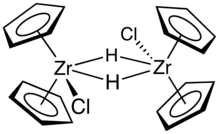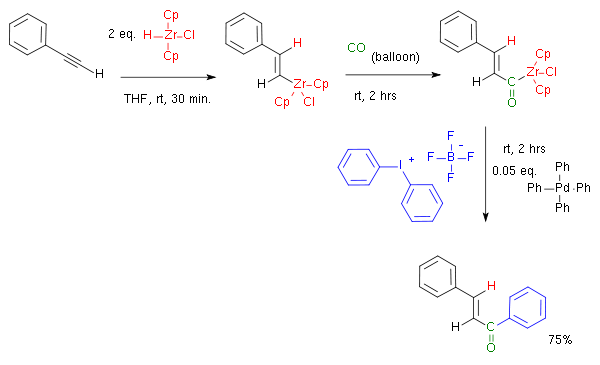Schwartz's reagent
| |||
| Names | |||
|---|---|---|---|
| IUPAC name
chloridobis(η5-cyclopentadienyl)hydridozirconium | |||
| Other names
Cp2ZrClH, zirconocene chloride hydride | |||
| Identifiers | |||
3D model (JSmol) |
|||
| ChemSpider | |||
| ECHA InfoCard | 100.048.599 | ||
| |||
| |||
| Properties | |||
| C10H11ClZr | |||
| Molar mass | 257.87 g/mol | ||
| Appearance | White solid | ||
Except where otherwise noted, data are given for materials in their standard state (at 25 °C [77 °F], 100 kPa). | |||
| Infobox references | |||
Schwartz's reagent is the common name for the chemical compound with the formula (C5H5)2ZrHCl, sometimes called zirconocene hydrochloride or zirconocene chloride hydride, and is named after Jeffrey Schwartz, a chemistry professor at Princeton University. This metallocene is used in organic synthesis for various transformations of alkenes and alkynes.[1][2][3]
Preparation
The complex was first prepared in crude form by Wailes and Weigold.[4] It can be purchased or readily prepared by reduction of zirconocene dichloride with lithium aluminium hydride:
- (C5H5)2ZrCl2 + 1⁄4 LiAlH4 → (C5H5)2ZrHCl + 1⁄4 LiAlCl4
In practice this reaction also affords (C5H5)2ZrH2, which is treated with methylene chloride to give the mixed hydride chloride.[5] An alternative procedure that generated Schwartz's Reagent from dihydride has also been reported.[6]
Structure
Schwartz's reagent has not been characterized by X-ray crystallography, but its structure has been analyzed by FT-IR spectroscopy, which establish that the hydrides are bridging. Solid state NMR spectroscopy points also to a dimeric structure, as observed by X-ray crystallography for (C5H5)4Zr2H2(CH3)2.[7]
Uses in organic synthesis
Schwartz's reagent can be used for a number of reactions. It has been shown that it can be used to reduce amides to aldehydes. Reducing tertiary amides with Schwartz's reagent can reach efficient yields, but primary and secondary amides will show decreased yields. The use of Schwartz's reagent in this manner will not require any added heat and can be done quickly, and reduction of the alcohol form is not a problematic side reaction as it can be with other reducing agents. Schwartz's reagent will selectively reduce the amide over any readily reducible esters that may be present in the reaction mixture.[8]
Vinylation of ketones in high yields is a possible use of Schwartz's reagent.[9]
Schwartz's reagent is used in the synthesis of some macrolide antibiotics,[10][11] (−)-motuporin,[12] and antitumor agents.[13]
Hydrozirconation
Hydrozirconation is a form of hydrometalation. Substrates for hydrozirconation are alkenes and alkynes. With terminal alkynes the terminal vinyl zirconium product is predominantly formed. Secondary reactions are nucleophilic additions, transmetalations,[14] conjugate additions,[15] coupling reactions, carbonylation and halogenation.
Computational studies indicate that hydrozirconation occurs from the interior portion.[16][17] When treated with one equivalent of Cp2ZrClH, diphenylacetylene gives the corresponding alkenylzirconium as a mixture of cis and trans isomers. With two equivalents of hydride, the endproduct was a mixture of erythro and threo zircono alkanes:
In 1974 Hart and Schwartz reported that the organozirconium intermediates react with electrophiles such as hydrochloric acid, bromine and acid chlorides to give the corresponding alkane, bromoalkanes, and ketones:[18]
The corresponding organoboron and organoaluminum compounds were already known, but these are air-sensitive and/or pyrophoric whereas organozirconium compounds are not.
Scope
In one study the usual regioselectivity of an alkyne hydrozirconation is reversed with the addition of zinc chloride:[19][20]
One example of a one-pot hydrozirconation - carbonylation - coupling is depicted below:[21][22]
With certain allyl alcohols, the alcohol group is replaced by nucleophilic carbon forming a cyclopropane ring:[23]The selectivity of the hydrozirconation of alkynes has been studied in detail.[24][25] Generally, the addition of the Zr–H proceeds via the syn-addition. The rate of addition to unsaturated carbon-carbon bonds is terminal alkyne > terminal alkene ≈ internal alkyne > disubstituted alkene [26] Acyl complexes can be generated by insertion of CO into the C–Zr bond resulting from hydrozirconation.[27] Upon alkene insertion into the zirconium hydride bond, the resulting zirconium alkyl undergoes facile rearrangement to the terminal alkyl and therefore only terminal acyl compounds can be synthesized in this way. The rearrangement most likely proceeds via β-hydride elimination followed by reinsertion.
References
- ↑ Hart, D. W.; Schwartz, J. (1974). "Hydrozirconation. Organic Synthesis via Organozirconium Intermediates. Synthesis and Rearrangement of Alkylzirconium(IV) Complexes and Their Reaction with Electrophiles". J. Am. Chem. Soc. 96 (26): 8115–8116. doi:10.1021/ja00833a048.
- ↑ Schwartz, J.; Labinger, J. A. (2003). "Hydrozirconation: A New Transition Metal Reagent for Organic Synthesis". Angew. Chem. Int. Ed. 15 (6): 330–340. doi:10.1002/anie.197603331.
- ↑ Hart, Donald W.; Blackburn, Thomas F.; Schwartz, Jeffrey (1975). "Hydrozirconation. III. Stereospecific and regioselective functionalization of alkylacetylenes via vinylzirconium(IV) intermediates". J. Am. Chem. Soc. 97 (3): 679–680. doi:10.1021/ja00836a056.
- ↑ Wailes, P. C.; Weigold, H. (1970). "Hydrido complexes of zirconium I. Preparation". J. Organomet. Chem. 24 (2): 405–411. doi:10.1016/S0022-328X(00)80281-8.
- ↑ Buchwald, S. L.; LaMaire, S. J.; Nielsen, R. B.; Watson, B. T.; King, S. M. "Schwartz's Reagent". Organic Syntheses. ; Collective Volume, 9, p. 162
- ↑ Wipf, Peter; Takahashi, Hidenori; Zhuang, Nian (1998). "Kinetic vs. thermodynamic control in hydrozirconation reactions" (PDF). Pure Appl. Chem. 70 (5): 1077–1082. doi:10.1351/pac199870051077.
- ↑ Rossini, A. J.; Mills, R. W.; Briscoe, G. A.; Norton, E. L.; Geier, S. J.; Hung, I.; Zheng, S.; Autschbach, J.; Schurko, R. W. (2009). "Solid-State Chlorine NMR of Group IV Transition Metal Organometallic Complexes". Journal of the American Chemical Society. 131: 3317–3330. doi:10.1021/ja808390a.
- ↑ Leighty, M. W.; Spletstoser, J. T.; Georg, Gunda I. (2011). "Mild Conversion of Tertiary Amides to Aldehydes Using Cp2ZrHCl (Schwartz's Reagent)". Org. Synth. 88: 427–437.
- ↑ Li, H.; Walsh, P. J. (2005). "Catalytic Asymmetric Vinylation and Dienylation of Ketones". J. Am. Chem. Soc. 127: 8355–8361. doi:10.1021/ja0425740.
- ↑ Duffey, Matthew O.; Le Tiran, Arnaud; Morken, James P. (2003). "Enantioselective Total Synthesis of Borrelidin". J. Am. Chem. Soc. 125: 1458–1459. doi:10.1021/ja028941u.
- ↑ Wu, J.; Panek, J. S. (2011). "Total Synthesis of (−)-Virginiamycin M2: Application of Crotylsilanes Accessed by Enantioselective Rh(II) or Cu(I) Promoted Carbenoid Si–H Insertion". J. Org. Chem. 76 (24): 9900–9918. doi:10.1021/jo202119p.
- ↑ Hu, T.; Panek, J. S. (1999). "Total Synthesis of (−)-Motuporin". J. Org. Chem. 64: 3000–3001. doi:10.1021/jo9904617.
- ↑ Nicolaou, K. C.; et al. (2003). "Total Synthesis of Apoptolidin: Completion of the Synthesis and Analogue Synthesis and Evaluation". J. Am. Chem. Soc. 125: 15443–15454. doi:10.1021/ja030496v.
- ↑ "Allylic alcohols by alkene transfer from zirconium to zinc: 1-[(tert-butyldiphenylsilyl)oxy]-dec-3-en-5-ol". Organic Syntheses. 9 (74): 205. 1998. Retrieved 2013-03-23.
Organic Syntheses, Coll. Vol. 9, p.143 (1998); Vol. 74, p.205 (1997).
- ↑ Conjugate Addition Of A Vinylzirconium Reagent: 3-(1-Octen-1-Yl)Cyclopentanone, Organic Syntheses, Coll. Vol. 9, p.640 (1998); Vol. 71, p.83 (1993).
- ↑ Pankratyev, E. Y.; Tyumkina, T. V.; Parfenova, L. V.; Khursan, S. L.; Khalilov, L. M.; Dzhemilev, U. M. (2011). "DFT and Ab Initio Study on Mechanism of Olefin Hydroalumination by XAlBui2 in the Presence of Cp2ZrCl2 Catalyst. II.(1) Olefin Interaction with Catalytically Active Centers". Organometallics. 30 (22): 6078–6089. doi:10.1021/om200518h.
- ↑ Wang, Juping; Xu, Huiying; Gao, Hui; Su, Cheng-Yong; Zhao, Cunyuan; Phillips, David Lee (2010). "DFT Study on the Mechanism of Amides to Aldehydes Using Cp2Zr(H)Cl". Organometallics. 29 (1): 42–51. doi:10.1021/om900371u.
- ↑ Hart, D. W.; Schwartz, J. (1974). "Hydrozirconation. Organic Synthesis via Organozirconium Intermediates. Synthesis and Rearrangement of Alkylzirconium(1V) Complexes and Their Reaction with Electrophiles". Journal of the American Chemical Society. 96 (26): 8115–8116. doi:10.1021/ja00833a048.
- ↑ Directed Hydrozirconation of Propargylic Alcohols Donghui Zhang and Joseph M. Ready J. Am. Chem. Soc., 129 (40), 12088 -12089, 2007. doi:10.1021/ja075215o
- ↑ The electrophile in this reaction is iodine. The additive is believed to promote kinetic reaction control.
- ↑ Palladium-catalyzed coupling reaction of acylzirconocene chlorides with hypervalent iodonium salts: synthesis of aryl-substituted ketones Suk-Ku Kang and Seok-Keun Yoon J. Chem. Soc., Perkin Trans. 1, 2002, 459 - 461, doi:10.1039/b110983a
- ↑ Reagents: phenylacetylene, Schwartz's reagent, tetraphenylpalladium and the iodane diphenyliodoniumtetrafluoroborate (phenyl group donor)
- ↑ A one-pot access to cyclopropanes from allylic ethers via hydrozirconation–deoxygenative ring formation Vincent Gandon, Jan Szymoniak, Chem. Commun., 2002, (12),1308-1309 doi: 10.1039/b203762a
- ↑ Sun, R. C.; Okabe, M.; Coffen, D. L.; Schwartz, J. (1998). "Conjugate Addition of a Vinylzirconium Reagent: 3-(1-Octene-1-yl)cyclopentanone". Organic Syntheses. ; Collective Volume, 9, p. 640
- ↑ Panek, J. S.; Hu, T. (1997). "Stereo- and Regiocontrolled Synthesis of Branched Trisubstituted Conjugated Dienes by Palladium(0)-Catalyzed Cross-Coupling Reaction". J. Org. Chem. 62 (15): 4912–4913. doi:10.1021/jo970647a.
- ↑ Wipf, Peter; Jahn, Heike (1996). "Synthetic applications of organochlorozirconocene complexes". Tetrahedron. 52 (40): 12853–12910. doi:10.1016/0040-4020(96)00754-5.
- ↑ Bertelo, Christopher A.; Schwartz, Jeffrey (1975). "Hydrozirconation. II. Oxidative homologation of olefins via carbon monoxide insertion into the carbon-zirconium bond". J. Am. Chem. Soc. 97 (1): 228–230. doi:10.1021/ja00834a061.
External links
| Wikimedia Commons has media related to Schwartz's reagent. |
- Examples in organic synthesis at the University of Connecticut website




